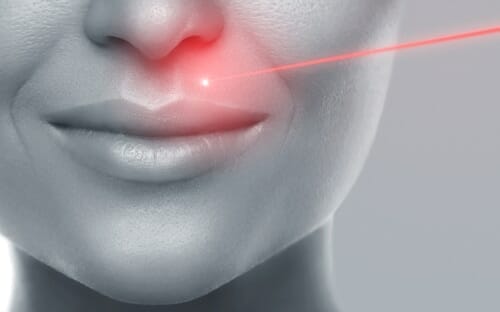Le photorajeunissement par laser CO2 fractionné ultra-pulsé
Pour traiter :
- Rides et ridules
- Signes de photovieillissement cutané
- Cicatrices (acné)
- Relâchement cutané (fripures du décolleté)
Le principe : Les lasers CO2, utilisés depuis 25 ans en dermatologie avaient des suites lourdes. Avec cette toute dernière génération de laser, le tir laser est fractionné, tamisé afin de préserver des îlots de peau saine sur la surface traitée. Il n’y a plus d’éviction sociale ( suites légères pendant une petite semaine).
Des résultats sont obtenus dès la première séance et s’améliorent pendant 6 mois.
Le patient ressent, pendant la séance, des picotements plus ou moins forts, suivis d’une sensation de coup de soleil qui disparaît rapidement.
La peau reste légèrement rouge et gonflée pendant quelques jours.
Le maquillage est possible après 48 heures.
Le photorajeunissement par laser CO2 fractionné et la photomodulation par les LED peuvent être combinés afin d’optimiser les résultats.
Le large plateau technique lasers de la Clinique du Lac permet d’entretenir les résultats obtenus par quelques séances annuelles de laser Xeo (NdYag et IPL) et Titan (infrarouge).

Qu’est-ce que le photorajeunissement ?
Le principe du photo rajeunissement est d’améliorer la texture et l’éclat de la peau par des séances d’exposition à des sources de lumière, comme la lumière intense pulsée (IPL), certains lasers ou des lumières douces de type LED. Ces machines, qui n’entrent pas en contact direct avec la peau, agissent directement sur les cellules de l’épiderme.
Les séances sont indolores et rapides. Elles permettent une récupération rapide, sans traces. Leur effet est immédiat, très naturel, mais transitoire. Ces séances doivent être répétées pour entretenir le résultat. Cette technique s’adresse aux personnes dont la peau s’est affinée avec l’âge et qui présentent des tâches brunes, des vaisseaux visibles ou des pores dilatés. Le visage, le décolleté, le dos des mains sont les zones les plus efficacement traitées par photorajeunissement lumineux. Ces techniques n’agissent que sur l’épiderme et elles peuvent être couplées avec d’autres qui agissent plus en profondeur. Une consultation avec le médecin est nécessaire. Il doit analyser votre demande, vos antécédents médicaux, familiaux, et examiner votre peau afin d’établir le protocole adapté.
Lors de la première consultation, signalez au praticien :
- les allergies éventuelles,
- les réactions anormales survenues lors d’un précédent traitement,
- les traitements médicamenteux en cours.
Durant les 2 semaines précédant une séance :
- appliquez une protection solaire (d’un indice de protection supérieur ou égal à 40),
- évitez l’exposition au soleil et les séances d’UV.
Le traitement devra être reporté en cas de grossesse.
Chaque séance dure entre 15 et 40 minutes. Il faut compter 4 à 6 séances, espacées d’environ 1 mois chacune.
Le médecin étale parfois un gel conducteur sur la surface à traiter. Il appose ensuite sur la peau une pièce à main délivrant des impulsions lumineuses. Chaque impulsion procure une sensation de chaleur, parfois de picotements.
Une crème protectrice est souvent appliquée à la fin de la séance.
Vous pouvez reprendre vos activités habituelles en sortant du cabinet.
Un léger érythème peut apparaître sur la zone traitée après la séance. Il se dissipe en 1 à 2 heures. Le médecin vous prescrira un soin apaisant. Le photorajeunissement n’entraîne aucune éviction sociale.
Dormez la tête légèrement surélevée les deux premières nuits, afin de réduire le risque d’ œdème.
Appliquez une protection solaire sur la région traitée (d’un indice de protection supérieur ou égal à 40) durant deux semaines.
L’aspect de la peau s’améliore nettement au bout de 3 séances.
Les résultats obtenus sont durables si la peau est quotidiennement hydratée et protégée du soleil.
Une ou deux séances d’entretien annuelles sont conseillées pour entretenir les effets du premier traitement.


